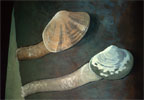|

|
There are many sandy
beach areas along the 400+ miles of
sanctuary coastline. (photo: Kip
Evans)
|
|

|
Beaches are not only
beautiful coastal areas, but they are also
important biological habitats. (photo: Kip
Evans)
|
|

|
Large marine mammals
such as sea lions and Elephant seals use
coastal beaches for breeding and pupping.
(photo: Kip Evans)
|
|

|
This female Elephant
seal and other female Elephant seals come
to Point Piedras Blancas and Ano Nuevo
each year to give birth. (photo: Kip
Evans)
|
|

|
While big waves pose
a threat to most of us, many animals live
in the near shore breakers. This Barred
Surfperch loves turbid water where it can
find food it needs to survive. (photo: Kip
Evans)
|
|

|
The intertidal zone
is an area constantly changing. Each day
along the Pacific Coast, presidents
experience two high and two low tides of
unequal height. (photo: Kip
Evans)
|
|

|
For the most part,
the intertidal is exposed during low tide.
During large swells, streams of cool water
rush over certain areas bringing relief to
many exposed invertebrates. (photo: Kip
Evans)
|
|

|
Animals that live in
the intertidal zone have to be specially
adapted to life with heat, wind, rain and
large crashing waves. Some animals like
starfish, hold on tight with suction cup
tube feet. Others like mussels, attach to
the reef with tough fibrous threads.
(photo: Kip Evans)
|
|

|
Harbor seals
haul-out on the rock intertidal to rest.
Along the shores of the Monterey Bay
National Marine Sanctuary hundreds of
harbor seals haul-out during the day where
they can be viewed by the general public.
(photo: Kip Evans)
|
|

|
Exposed rocky areas
are often used as resting sites for many
fish eating birds such as these cormorants
in the the sunset. (photo: Kip
Evans)
|
|

|
Wetlands are one of
the most misunderstood habitats on Earth.
(photo: Kip Evans)
|
|

|
90% of California's
wetlands have disappeared - lost to
airports, harbors, housing developments,
and parking lots. (photo: Kip
Evans)
|
|

|
Wetlands are one of
the most biologically productive places on
Earth. Here you can find hundreds of
different invertebrates, including clams,
which are an important food source for
birds, fish, and even humans. (photo: Kip
Evans)
|
|

|
Thousands of birds
visit or lie in the wetland areas along
the boundary of the Monterey Bay National
Marine Sanctuary. They come here for the
abundance of food and refuge that these
areas provide. (photo: Kip
Evans)
|
|

|
Sunlight filters
through the dense kelp canopy bringing
light to the sea floor, which allows
growth in the understory. (photo: Kip
Evans)
|

|
There are hundreds
of different types of invertebrates found
within the kelp forests of Monterey Bay
National Marine Sanctuary. (photo: Kip
Evans)
|

|
Adult harbor seals
like this one, feed, play, and find refuge
in kelp forests during the day. At night
they look for prey in deeper waters.
(photo: Kip Evans)
|

|
Thousands of divers
explore the kelp forest each year. (photo:
Kip Evans)
|
|

|
The Kelp rockfish is
one of the most common rockfish found in
the kelp forest of the Monterey Bay
National Marine Sanctuary. It spends most
of its time on or near the bottom where it
blends in with its surroundings. (photo:
Kip Evans)
|
|

|
Southern sea otters
are a common sight int he Sanctuary,
despite the fact that the overall
population is very endangered. Sea otters
use the kelp forests to eat, sleep, mate,
and hide from predators. (photo: Kip
Evans)
|
|

|
Unlike the rocky
intertidal zone, the open ocean is an area
that does not change much from day to day.
(photo: Kip Evans)
|
|

|
Transient Killer
whales (Orcas) wait near the edge of the
Monterey Bay canyon for gray whales to
pass by. Gray whales, sea ions, dolphins,
and other marine mammals are prey for
transient Killer whales. (photo: Kip
Evans)
|
|

|
Blue sharks spend
almost all their time in the open ocean.
They grow to a length of about 11-12 feet
and feed primarily on small fish. (photo:
Kip Evans)
|





